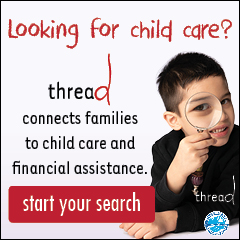
CHOOSING CHILDCARE
When it comes to making a
decision this big,
knowledge is power
Story by Mara Severin
When Heather Handyside began looking for childcare for her son Owen, she had a short list – but it was a tall order. “I wanted someone who would not only care for my child, but love my child while I was away from him all day.”
Her sentiments resonate with Vanessa Kitchen, who recalls looking for childcare for her first son, Gavin. “You feel like nobody besides yourself could possibly provide good enough care for your prized possession.”
Finding the perfect childcare solution for your family will never be easy. That’s the bad news. The good news? You’re not alone. There are tools you can use and resources to tap that will help you find just the right environment for you child.
To execute a successful search, you need to be one part detective, one part journalist, and one part gossip. In other words, you need to ask questions. Lots of them.
Talk to yourself – you’d be crazy not to
thread Alaska in Anchorage is an essential first stop in your search. The nonprofit helps Alaskan parents find the best childcare possible, offering not only referrals but also excellent suggestions on how to conduct your search. And they know that if you want the right answers, you have to ask the right questions.
Begin with yourself, suggests Betsy Harris, the organization’s program coordinator. Ask the mundane questions first: What is our budget? How far am I willing to drive?
And then move on to the tougher ones: Is my child shy? Outgoing? Active? Subdued? “Temperament is a very important thing to consider,” says Harris. Some children will thrive in a busy, active facility, whereas others might prefer a quieter home environment.
Also consider your child’s age. “Children at different ages require different things,” she says. “Babies need to be held, talked to and played with,” she says, so you should be confident that your infant is in the hands of someone with the time and freedom to give her the attention she needs.
Give gossip a good name
Co-workers, friends and neighbors may have the inside scoop on excellent providers and programs (and those to avoid). Word-of-mouth referrals can lead to positive results.
Once you’ve made some choices, put them to the test. thread Alaska's web site has a Quality Indicator Guide that provides interview questions, checklists and a list of red flags to help you assess potential childcare environments. Visit each location during regular daytime hours. Observe closely. Ask the questions in the guide and ask your own. Picture your own child there.
What to look for – and what to look out for
Some things are easy to assess, says Stephanie Berglund, chief operating officer and program director of thread Alaska. For starters, “the environment should look and smell clean.” The children should have lots of materials to play with. The caregivers should be actively engaged with the children and not leaving them to “do their own thing,” she says.
But when it comes to policies, you absolutely have to ask, she says. Unfamiliar people should not be allowed to care for your children at any time – any new care provider should be introduced to both the parents and the children before they have hands-on time with your children. Also, adds Harris, “Parents should be welcome to drop in at any time.”
The first day – pictures, watches and hankies
Once you’ve done your homework and made a choice, it’s time to start preparing for that important first day. “Talk to your child,” says Harris. Talk about what a day at childcare might be like. “You can create a storyboard at home that show’s the day’s activities in order,” she suggests. Simple details like hanging up your coat, getting a snack, going outside are easy for children to grasp and can be comforting.
Bring family photos, suggests Harris, to help with the transition. A watch with an alarm setting can help children mark passing time throughout the day. Phone calls work too, she says, and “they should always be welcome.” Be prepared on that first day, warns Ashley Barrera, a childcare provider at Puffin Heights Montessori School.
Barrera has seen her share of the first day jitters. “They will cry and you will too,” she says knowingly. “And that’s normal.” She says that the children dry their eyes and settle down within minutes.
The information pipeline
Once your child is settled into his new routine, you might be tempted to stop asking questions. Don’t. Your family’s relationship with your childcare provider is a dynamic one that is always changing. They should welcome the chance to provide information.
“I probably drove my day care provider crazy giving her the 3rd degree,” recalls Heather. But her provider had an excellent system for calming her nerves. She kept a daily journal for each child in her care. “She kept track of every bottle, naptime, and diaper change,” she says. A fresh bottle, a clean diaper and daily reassurance? Now that’s love.










